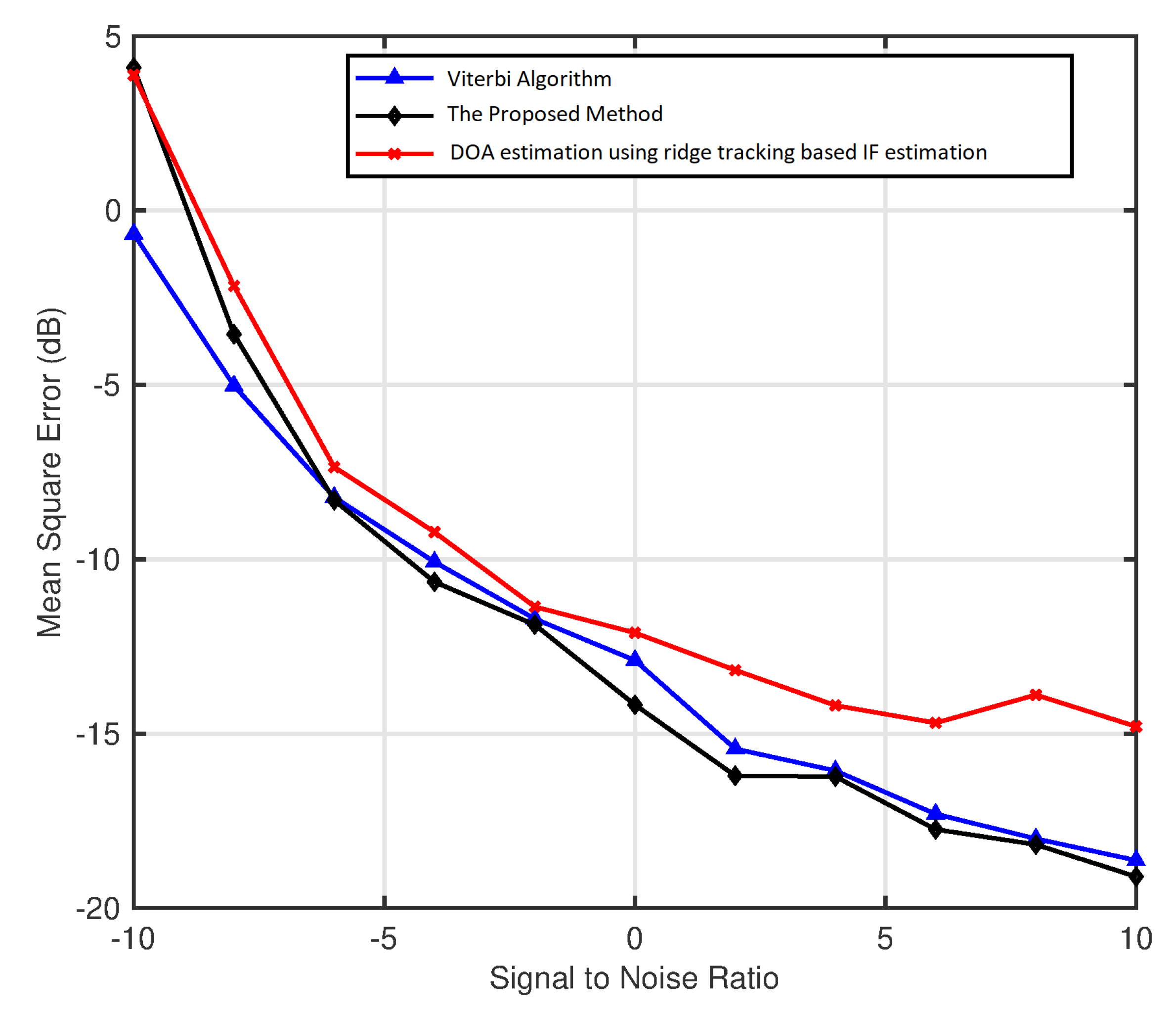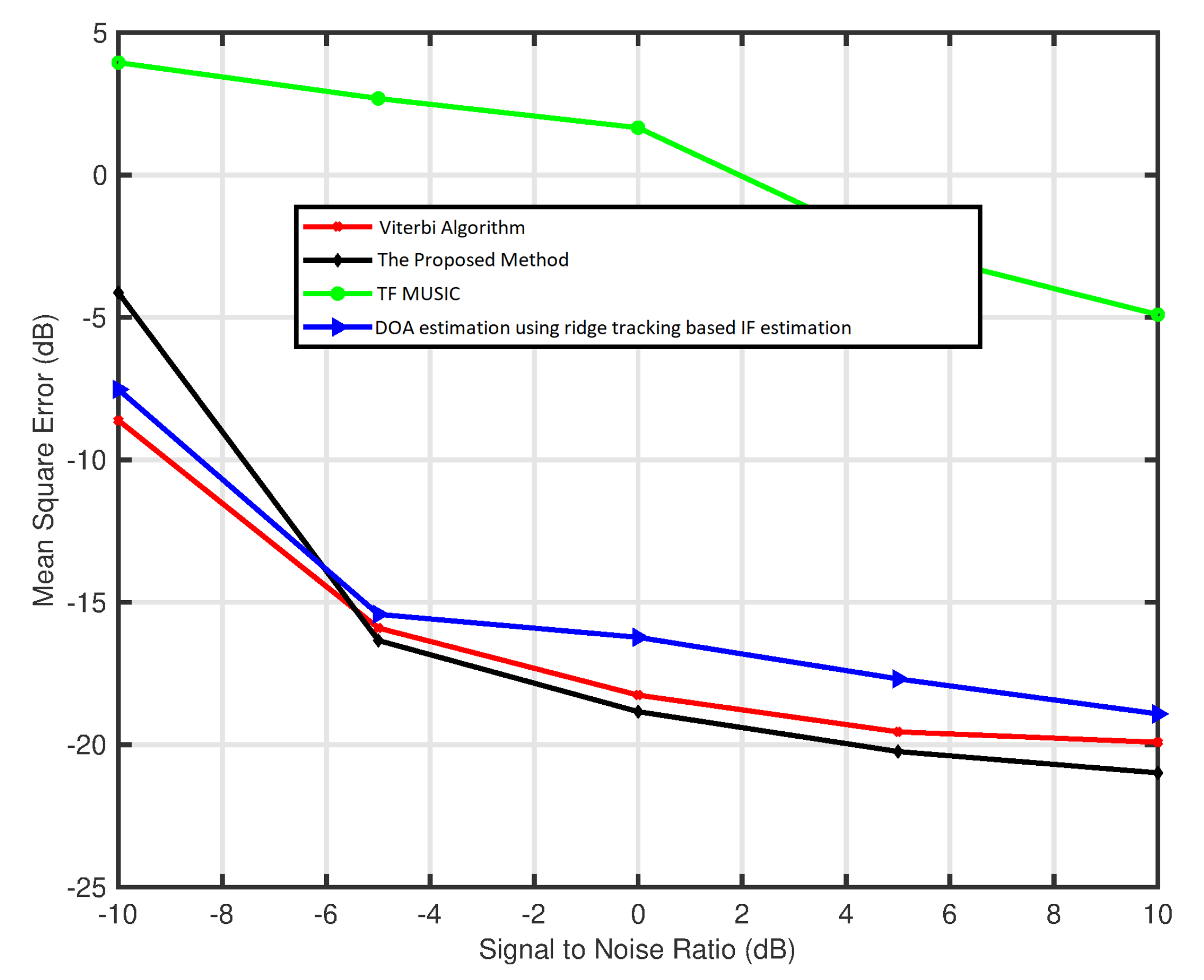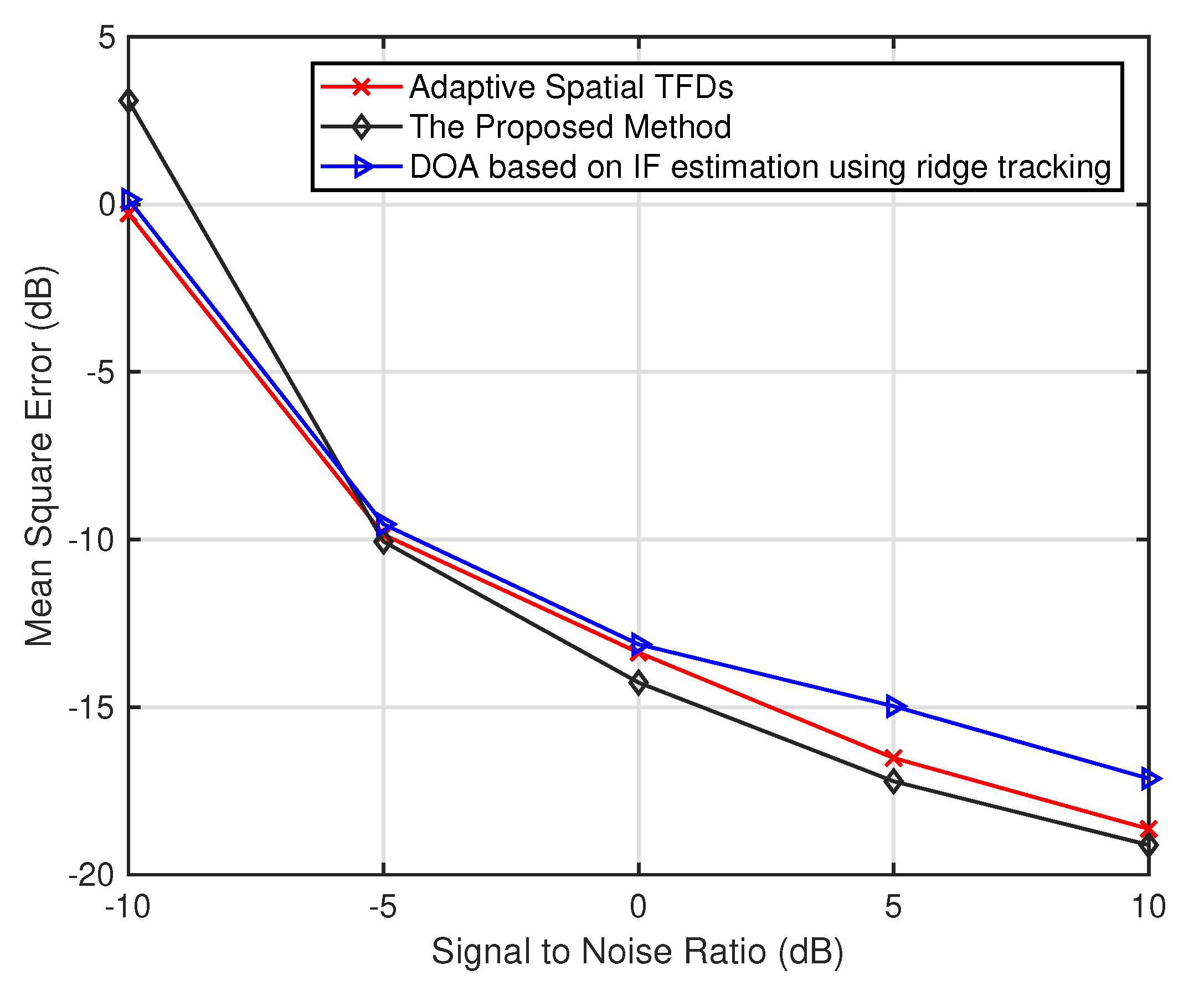An Efficient Direction of Arrival Estimation Algorithm for Sources with Intersecting Signature in the Time–Frequency Domain
Abstract
1. Introduction
- The method can achieve good performance in low signal to noise ratios in both under-determined and over-determined scenario.
- The method is applicable to a large class of signals and does not require signals to have a non-overlapping signature in the TF domain or follow a specific mathematical model.
- The method is computationally efficient as compared to the methods of similar performance.
- A computationally efficient and accurate multi-sensor IF estimation algorithm is developed that achieves better performance without requiring the computation of Adaptive directional time–frequency distributions [28] or Viterbi algorithm [26] thus both reducing computational cost and resulting in improved performance.
2. Signal Model
3. Methodology
3.1. Multi-Sensor IF Estimation Algorithm
3.1.1. Finding out Highest Energy Time-Instant
3.1.2. Estimation of the Highest Energy Frequency Bin
3.1.3. IF Estimation
3.2. TF Filtering Using IF and Covariance Matrix Estimation
3.3. Source Localization Using MUSIC Algorithm
- Both eigenvectors, i.e., , and the corresponding eigenvalues, i.e., are computed from .
- The signal space is represented by the largest Eigen vector, i.e., , and noise space is represented by the remaining vectors as there is the only one source in . The DOA is estimated from the peak of the spatial spectrum [1]:
4. Computational Complexity
5. Experimental Results
5.1. Two Sources
5.2. Three Source Signals
5.3. Interpretation of Results
6. Conclusions
Author Contributions
Funding
Institutional Review Board Statement
Informed Consent Statement
Data Availability Statement
Conflicts of Interest
References
- Trees, H.L.V. Optimum Array Processing; Wiley Interscience: New York, NY, USA, 2002. [Google Scholar]
- Swindlehurst, A.; Kailath, T. A performance analysis of subspace-based methods in the presence of model errors. I. The MUSIC algorithm. IEEE Trans. Signal Process. 1992, 40, 1758–1774. [Google Scholar] [CrossRef]
- Kassis, C.E.; Picheral, J.; Mokbel, C. Advantages of nonuniform arrays using root-MUSIC. Signal Process. 2010, 90, 689–695. [Google Scholar] [CrossRef]
- Zhang, Y.; Ma, W.; Amin, M. Subspace analysis of spatial time-frequency distribution matrices. IEEE Trans. Signal Process. 2001, 49, 747–759. [Google Scholar] [CrossRef]
- Amin, M.G.; Zhang, Y. Direction Finding Based on Spatial Time-Frequency Distribution Matrices. Digit. Signal Process. 2000, 10, 325–339. [Google Scholar] [CrossRef]
- Chabriel, G.; Kleinsteuber, M.; Moreau, E.; Shen, H.; Tichavsky, P.; Yeredor, A. Joint Matrices Decompositions and Blind Source Separation: A survey of methods, identification, and applications. IEEE Signal Process. Mag. 2014, 31, 34–43. [Google Scholar] [CrossRef]
- Belouchrani, A.; Amin, M. Time-frequency MUSIC. IEEE Signal Process. Lett. 1999, 6, 109–110. [Google Scholar] [CrossRef]
- Khan, N.A.; Ali, S. Robust spatial time-frequency distributions for DOA estimation using spatial averaging and directional smoothing. Signal Process. 2021, 180, 107897. [Google Scholar] [CrossRef]
- Boashash, B.; Aïssa-El-Bey, A.; Al-Sa’d, M.F. Multisensor Time–Frequency Signal Processing MATLAB package: An analysis tool for multichannel non-stationary data. SoftwareX 2018, 8, 53–58. [Google Scholar] [CrossRef]
- Boashash, B.; Aïssa-El-Bey, A. Robust multisensor time–frequency signal processing: A tutorial review with illustrations of performance enhancement in selected application areas. Digit. Signal Process. 2018, 77, 153–186. [Google Scholar] [CrossRef]
- Zhang, Y.D.; Amin, M.G.; Himed, B. Direction of arrival estimation of nonstationary signals exploiting signal characteristics. In Proceedings of the 11th International Conference on Information Science, Signal Processing and Their Applications (ISSPA), Montreal, QC, Canada, 2–5 July 2012; pp. 1223–1228. [Google Scholar]
- Guo, L.; Zhang, Y.; Wu, Q.; Amin, M. DOA estimation of sparsely sampled nonstationary signals. In Proceedings of the IEEE China Summit and International Conference on Signal and Information Processing (ChinaSIP), Chengdu, China, 12–15 July 2015; pp. 300–304. [Google Scholar] [CrossRef]
- Khan, N.A.; Ali, S. Sparsity-aware adaptive directional time–frequency distribution for source localization. Circuits Syst. Signal Process. 2018, 37, 1223–1242. [Google Scholar] [CrossRef]
- Ouelha, S.; Aïssa-El-Bey, A.; Boashash, B. Improving DOA Estimation Algorithms Using High-Resolution Quadratic Time-Frequency Distributions. IEEE Trans. Signal Process. 2017, 65, 5179–5190. [Google Scholar] [CrossRef]
- Heidenreich, P.; Cirillo, L.; Zoubir, A. Morphological image processing for FM source detection and localization. Signal Process. 2009, 89, 1070–1080. [Google Scholar] [CrossRef]
- Sharif, W.; Chakhchoukh, Y.; Zoubir, A. Robust spatial time-frequency distribution matrix estimation with application to direction-of-arrival estimation. Signal Process. 2011, 91, 2630–2638. [Google Scholar] [CrossRef]
- Chen, S.; Dong, X.; Xing, G.; Peng, Z.; Zhang, W.; Meng, G. Separation of Overlapped Non-Stationary Signals by Ridge Path Regrouping and Intrinsic Chirp Component Decomposition. IEEE Sens. J. 2017, 17, 5994–6005. [Google Scholar] [CrossRef]
- Rankine, L.; Mesbah, M.; Boashash, B. IF estimation for multicomponent signals using image processing techniques in the time-frequency domain. Signal Process. 2007, 87, 1234–1250. [Google Scholar] [CrossRef]
- Linh-Trung, N.; Belouchrani, A.; Abed-Meraim, K.; Boashash, B. Separating more sources than sensors using time-frequency distributions. EURASIP J. Appl. Signal Process. 2005, 2005, 2828–2847. [Google Scholar] [CrossRef]
- Lerga, J.; Sucic, V.; Boashash, B. An efficient algorithm for instantaneous frequency estimation of nonstationary multicomponent signals in low SNR. EURASIP J. Adv. Signal Process. 2011, 2011, 725189. [Google Scholar] [CrossRef]
- Zhang, H.; Bi, G.; Cai, Y.; Razul, S.G.; See, C.M.S. DOA estimation of closely-spaced and spectrally-overlapped sources using a STFT-based MUSIC algorithm. Digit. Signal Process. 2016, 52, 25–34. [Google Scholar] [CrossRef]
- Zhang, X.; Zhang, W.; Yuan, Y.; Cui, K.; Xie, T.; Yuan, N. DOA estimation of spectrally overlapped LFM signals based on STFT and Hough transform. EURASIP J. Adv. Signal Process. 2019, 2019, 1–10. [Google Scholar] [CrossRef]
- Ghofrani, S.; Amin, M.G.; Zhang, Y.D. High-resolution direction finding of non-stationary signals using matching pursuit. Signal Process. 2013, 93, 3466–3478. [Google Scholar] [CrossRef]
- Khan, N.A.; Ali, S.; Mohammadi, M.; Akram, J. Novel direction of arrival estimation using Adaptive Directional Spatial Time-Frequency Distribution. Signal Process. 2020, 168, 107342. [Google Scholar] [CrossRef]
- Khan, N.A.; Ali, S.; Mohammadi, M.; Haneef, M. Direction of arrival estimation of sources with intersecting signature in time-frequency domain using a combination of IF estimation and MUSIC algorithm. Multidimens. Syst. Signal Process. 2020, 31, 549–567. [Google Scholar] [CrossRef]
- Khan, N.A.; Mohammadi, M.; Djurovic, I. A Modified Viterbi Algorithm-Based IF Estimation Algorithm for Adaptive Directional Time-Frequency Distributions. Circuits Syst. Signal Process. 2019, 38, 2227–2244. [Google Scholar] [CrossRef]
- Khan, N.A.; Ali, S. A Robust and Efficient Instantaneous Frequency Estimator of Multi-component Signals with Intersecting Time-Frequency Signatures. Signal Process. 2020, 117. [Google Scholar] [CrossRef]
- Khan, N.A.; Mohammadi, M.; Ali, S. Instantaneous frequency estimation of intersecting and close multi-component signals with varying amplitudes. Signal Image Video Process. 2019, 13, 517–524. [Google Scholar] [CrossRef]
- Khan, N.A.; Boashash, B. Instantaneous frequency estimation of multicomponent nonstationary signals using multiview time-frequency distributions based on the adaptive fractional spectrogram. IEEE Signal Process. Lett. 2013, 20, 157–160. [Google Scholar] [CrossRef]
- Yang, Y.; Dong, X.; Peng, Z.; Zhang, W.; Meng, G. Component Extraction for Non-Stationary Multi-Component Signal Using Parameterized De-chirping and Band-Pass Filter. IEEE Signal Process. Lett. 2015, 22, 1373–1377. [Google Scholar] [CrossRef]
- Ali Khan, N.; Ali, S.; Jansson, M. Direction of arrival estimation using adaptive directional time-frequency distributions. Multidimens. Syst. Signal Process. 2018, 29, 503–521. [Google Scholar] [CrossRef]
- Li, P.; Zhang, Q.H. An improved Viterbi algorithm for IF extraction of multicomponent signals. Signal Image Video Process. 2018, 12, 171–179. [Google Scholar] [CrossRef]
- Djurovic, I.; Stankovic, L. An algorithm for the Wigner distribution based instantaneous frequency estimation in a high noise environment. Signal Process. 2004, 84, 631–643. [Google Scholar] [CrossRef]









Publisher’s Note: MDPI stays neutral with regard to jurisdictional claims in published maps and institutional affiliations. |
© 2021 by the authors. Licensee MDPI, Basel, Switzerland. This article is an open access article distributed under the terms and conditions of the Creative Commons Attribution (CC BY) license (http://creativecommons.org/licenses/by/4.0/).
Share and Cite
Khan, N.A.; Ali, S.; Choi, K. An Efficient Direction of Arrival Estimation Algorithm for Sources with Intersecting Signature in the Time–Frequency Domain. Appl. Sci. 2021, 11, 1849. https://doi.org/10.3390/app11041849
Khan NA, Ali S, Choi K. An Efficient Direction of Arrival Estimation Algorithm for Sources with Intersecting Signature in the Time–Frequency Domain. Applied Sciences. 2021; 11(4):1849. https://doi.org/10.3390/app11041849
Chicago/Turabian StyleKhan, Nabeel Ali, Sadiq Ali, and Kwonhue Choi. 2021. "An Efficient Direction of Arrival Estimation Algorithm for Sources with Intersecting Signature in the Time–Frequency Domain" Applied Sciences 11, no. 4: 1849. https://doi.org/10.3390/app11041849
APA StyleKhan, N. A., Ali, S., & Choi, K. (2021). An Efficient Direction of Arrival Estimation Algorithm for Sources with Intersecting Signature in the Time–Frequency Domain. Applied Sciences, 11(4), 1849. https://doi.org/10.3390/app11041849







